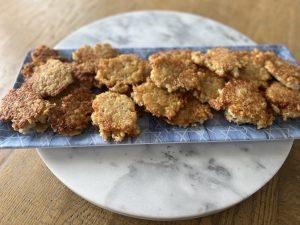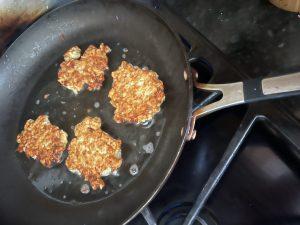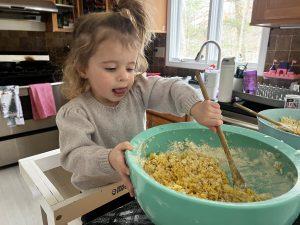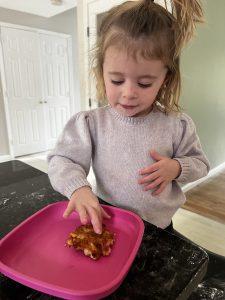
Hanukkah is upon us, and for my family that means it is time to make the latkes. They are a delicious snack or appetizer, and for those who might be apprehensive about making latkes from scratch, don’t worry! They are not difficult to make. While you’re cooking, the smell of the latkes fills the house, and the taste brings me right back to childhood. As a bonus, my two children – who are very picky eaters – like to eat them too. Like previous recipes I’ve shared, in my experience when kids help cook, they are more likely to try what they make. Making latkes with kids is a great idea!
If you’ve never tried potato latkes before, you are missing out. Latkes are similar to a hashbrown patty, but in my opinion, they are more flavorful and taste better. Latkes can be served with a variety of toppings to accentuate the flavor. After getting all the ingredients, follow my step-by-step recipe and I promise you’ll thank me later.
The 6 Ingredients

- 5 lbs Russet Potatoes (peeled and sliced into chunks)
- 2 Sweet Onions (peeled and sliced into chunks)
- 2 Cups Flour
- 1 tbs Baking Powder
- 1 tbs Salt
- Vegetable Oil
Getting Down to Business
I always go big when making potato latkes. Why? Because you can never have enough. Latkes freeze well as long as you do so properly, and when re-heated they taste just like they did fresh out of the oven. Plus, if you’re going to get your kitchen a bit messy during the cooking process, you might as well be all in! With that said, making a small batch of latkes is always an option if you prefer. In the past, I’ve varied the amount of potatoes I use depending on whether I’m entertaining, but this year I went with the whole 5-pound bag in advance of hosting friends in a couple days. You can easily pare down the ingredients I listed above to measurements that suit your needs. For reference, my batch resulted in filling about two one-gallon bags worth of potato latkes.
To get started making latkes, you first will need to peel your potatoes.
Next, I cut my potatoes into chunks. I also peel and cut my onions (I used two Vidalia onions) as well.

For the next step, you can use a heavy-duty blender like the Vitamix or a Food Processor. I happen to have a Vitamix and have found it works very well. This explains why you will first want to dice up the potatoes and onions into small chunks. I then put small batches of potatoes and onions into the Vitamix until they have a shredded consistency. Once they are blended, I place the shredded mix into a large bowl.
Once all of your potatoes and onions are shredded to your liking, you will need to strain out as much water as you can. I take a dish towel and put it inside of a strainer. I pour small batches of the mixture inside and then squeeze out whatever water I can. You will want to keep doing this until you get through all of the potatoes and onions. As I strain each batch, I transfer the strained mixture into a different large bowl to keep track.
Once the entire mixture is strained, you will add in your eggs, flour, salt and baking powder. I put in 6 eggs, 2 cups of flour, 1 tablespoon of salt and 1 tablespoon of baking powder and mix with a wooden spoon. When working with such a big batch, I have found it easier to separate the mixture into two separate bowls.

Next, you will want to take out a frying pan (or two frying pans, depending on your comfort level of cooking multiple latkes at the same time) and fill it up with about a half an inch of vegetable oil. I recommend using a frying pan that is deeper to prevent as much oil as possible from splattering. I turn up my burner to medium heat and make sure the oil is hot before I begin frying. You will know what temperature is best for your burner, just be mindful not to have your burner temperature too high or the latkes will burn.
To fry up your latkes, you will want to scoop small amounts of the mixture into the hot oil. For reference, I use the ¼ measuring cup as a guide. Let the latke mixture fry on one side until golden brown and then flip over to the other side.
Once done frying both sides, transfer the latke to a plate with paper towel so you can drain any excess oil.
Repeat this process until you have made all of your latkes!
Making Latkes with Kids

Making potato latkes might not seem like an activity for your young kids, but you can definitely involve your kids and have fun. My youngest, two-year-old Addison, was my helper this year and she absolutely loved being in charge of putting the ingredients into the blender. She was also a big fan of mixing up everything into the bowls. Did some of the ingredients spill out in the process because a two-year old isn’t exactly gentle with a wooden spoon? Yes, of course, but our latkes still tasted delicious!
Time to Eat

Latkes taste best when hot. If you’re not serving the latkes right away, you can always freeze or refrigerate your latkes and then re-heat them in the oven or toaster oven. In my experience, when reheating latkes at 400 degrees, it only takes a few minutes for them to be ready.
There are so many great toppings to enjoy on top of your latkes. Apple sauce is a popular choice, as is sour cream (though I wouldn’t recommend trying apple sauce and sour cream at the same time). Some people also enjoy their latkes with ketchup.
In my family, my grandfather (Grampy) started a tradition by eating his latkes with sour cream and a sprinkle of sugar. This unique combination has been gained many fans through the years.
Happy Hanukkah! Do you have any topping suggestions for latkes or holiday family traditions you’d like to share? If so, I’d love to hear them. Feel free to tag @capecodmoms or @snfenlon on Instagram.








